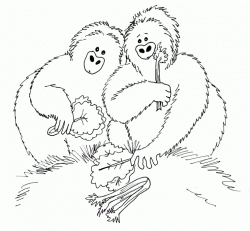Ape the apes: Gorilla diet could save your life
Q. Guess who primatologist Kristen Lucas and her PhD student E.L. put on a crash diet, with great success. –D. Fossey
A. Two gorillas at the Cleveland Metroparks Zoo, reports Case Western Reserve University's Think magazine. While males in the wild weigh about 350 pounds, the zoo's Mokolo and Bebac topped out at 460 and 430 pounds, putting them at risk of heart disease, the leading cause of death for male gorillas in captivity.
So a diet program was initiated, including green vegetables like romaine lettuce and alfalfa hay, more akin to the eating habits of gorillas in the wild. Gone were high-starch foods like carrots and bananas and high-sugar, high-calorie biscuits, replaced by sugar-free gummy vitamins.
Their diet now consists of five times as much food, requiring wheelbarrows instead of buckets to transport. It also forces the gorillas to work a little for their meals,
stripping leaves and bark from sticks and trying to track down pieces of hay. In the last year, Mokolo and Bebac have each shed 65 pounds as they've taken their new diet in stride.
"We used to give them biscuits for doing simple behaviors," says E.L., "but we weren't giving them enough credit. They don't need a sugary reward; they'll do it for green beans."
Q. What have digital cameras and digital photography rendered obsolete? –J. Fariello
A. Film and scrapbooks and albums and the whole reason why we used to take pictures, answers Tekla Perry in IEEE Spectrum magazine. Photographs used to be for capturing special moments as we documented our life history; today's digital images are free and easy and can be instantly distributed, now often communicating the ordinary with less forethought than a phone call.
In fact, adds Future Image founder Alexis Gerard, many images today communicate information that has value only in the moment: Where did I park my car? What does this office space look like? Even as an art form, photography is changing: If someone points a camera at a good image, the result will likely be a good image– there is no learning curve. "For the first time, we have a creative tool that people can jump into right away," she says.
The problem is what to do with the images once they're taken, says electrical engineer Steven Sasson. The scrapbooks and shoeboxes of the film world are being replicated in digital forms, but they're overloaded and becoming impossible to manage.
"This is the last frontier," Sasson concludes. "How do you save these images for 50 or 60 years, with format obsolescence, changing standards? Images are the only digital files that get more valuable the older they get."
Q. If chimps played ball, would they throw right- or left-handed? –J. Goodall
A. They'd be split about 50-50, as would monkeys, gorillas, etc., unlike the human population which is about 90 percent right-handed, 80 percent right-footed, 70 percent right-eyed and 60 percent right-eared, says Robert Ornstein in The Roots of the Self. This "right-eous" tendency in humans is probably a byproduct of the evolution of our left brain (controlling the right side of the body) as specialized for language and speech
Q. How many nibbles make up a byte? –B. Gates
A. As you already know, a "bit" is a contraction for "binary digit," the basic unit of computer information stored as 0/1, no/yes, off/on, false/true, say Stephen Battersby and Quentin Cooper in New Scientist magazine. Eight bits make up one standard "byte," spelled with a "y" to make it look more computery. A "nibble" (or "nybble," also featuring a "y") has four bits, so it takes two full nibbles for a byte.
~
Send Strange questions to brothers Bill and Rich at [email protected]
